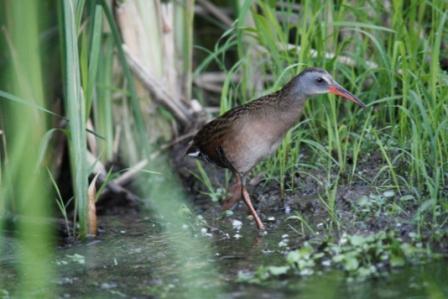|
 Photo taken by Nadje Najar
The Virginia Rail is more common than the Black Rail and significantly larger. That does not mean it is any easier to detect; these birds are still highly secretive. Virginia rails can be found in much of North America. They are distributed from coast to coast, far north into Canada and south into central Mexico. Virginia rails exist only in isolated wetland patches within this broad range. Year-round resident populations exist all along the west coast of the United States and extend some distance inland. The population of Virginia Rails that can be found in the foothills is part of this year-round resident group.
BRINGING VIRGINIA RAILS INTO THE BLACK RAIL PROJECT
While surveying for Black Rails in the Foothills, we noticed that Virginia Rails were found throughout the area. They often occupied the same wetlands as Black Rails and responded to our playing of Black Rail calls. We began to wonder what interactions they might have with Black Rails and how differences between species might affect their population dynamics and habitat use. Starting in 2006, we expanded our surveys to incorporate Virginia Rails into our research.
DESCRIPTION
Virginia Rails are medium-sized (length 22-27 cm) marsh birds with laterally compressed bodies that allow them to maneuver through dense marsh vegetation. They have mostly reddish brown feathers mottled with black but with gray cheeks, a white rump, and a long orange bill that is slightly curved. There is little that distinguishes males from females.
BEHAVIOR
Virginia Rails prefer moving on foot (although they can swim). They remain hidden in dense vegetation, but can be seen more often than Black Rails due to their larger size, brighter coloration, and greater tendency to fly from cover when disturbed. They can be heard making their distinctive grunt calls, often in pairs. More rarely, you may hear kicker or tick-it calls. Virginia Rails build nests hidden on the ground in vegetation and lay 4-13 eggs per clutch. Chicks are precocial, meaning they are relatively mature and mobile from the moment of hatching. Virginia rails are monogamous breeders and stay with their mates for the duration of the breeding season.
|
